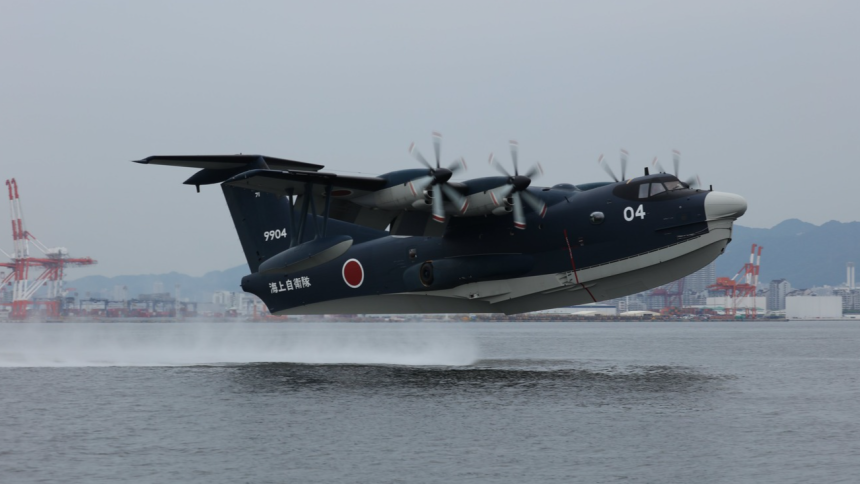The US-2 has the shortest take-off and landing distance on water, consistent with its need to operate as a SAR aircraft in the western Pacific islands.
The JMSDF (Japan Maritime Self-Defense Force) has received back one of its ShinMaywa US-2 amphibious aircrafts following maintenance and repairs. Primarily a SAR (Search and Rescue) aircraft, the amphibious plane (which has a flying boat design as it relies on its main hull for buoyancy) is operated by the JMSDF as a STOL (Short Take-Off Landing) for rescuing victims of maritime accidents.
In a post on X, the Kinki Chubu Defense Bureau said: “In late June 2024, US2 ‘9904’ completed regular repairs and was handed over to the JMSDF. In the future, we plan to use Iwakuni Air Base as our home base and engage in maritime rescue missions. Thank you to ShinMaywa Industries Co., Ltd. and all of our cooperating companies.”
The US-2 bearing the serial number ‘9904’ was seen landing in the water and photographed near the hangar with personnel from the JMSDF and naval base, and presumably engineers from ShinMaywa. It is not known if this was the only plane in the unit that underwent repairs, although the press release suggests it was a part of a scheduled maintenance.
令和6年6月下旬、#US2 9904号機は、定期修理を終了し、#海上自衛隊 に引き渡されました。今後 #岩国航空基地 を母基地として海上救難任務に従事し、活躍する予定です。#新明和工業株式会社 様をはじめ協力会社の皆様ありがとうございました。#近畿中部防衛局 pic.twitter.com/ACo2B1mAkx
— 防衛省近畿中部防衛局 (@KinkichubuDB) July 8, 2024
Used only by Japan
A successor to Japan’s older US-1A amphibious seaplanes, the four-engined US-2’s defining feature is the BLC (Boundary Layer Control) technology, which controls the layer of air around the wing to sustain lift at low speeds without stalling. The US-2s are operated by the JMSDF’s 71 Kokutai (71st Flight Squadron) at Iwakuni air base.
As of November 2018, the JMSDF was operating six US-2s, with the intention to operate around 14 more. By Sep. 2022, ShinMaywa revealed it was “manufacturing unit no. 9,” in the context of a report about the USSOCOM (US Special Operations Command) interest in the US-2 for acquiring a seaplane capability.
U.S. Air Force (USAF) and RAAF (Royal Australian Air Force) personnel also had the opportunity to see the US-2’s capabilities during the Cope North 22 HADR (Humanitarian Assistance Disaster Relief) exercise near Andersen AFB in Guam.
Japan Maritime Self-Defense Force ShinMaywa US-2 floats in the ocean while US Air Force HH-60G with 33rd Rescue Squadron hover nearby during Exercise Cope North 22 at the Island of Tinian on Feb. 14. pic.twitter.com/K8LmjNr2D9
— Ryan Chan 陳家翹 (@ryankakiuchan) February 23, 2022
The aircraft was also a major agenda item in Indian and Japanese relations. New Delhi, desirous of operating 12 such units for its island regions, sought local assembly of the plane, as a part of its industrial and employment generation vision, and to reduce costs by 25%. However, reports by Dec. 2019 said that the issue was diminishing in diplomatic agendas and that the Indian Navy did “not” perceive it as “high on the priority list” and faced “budget constraints.”
Excellent seaplane
The plane has excellent performance and kinematic characteristics consistent with its intended purpose. According to a report from the Sasakawa Peace Foundation, the climb-out and approach speeds while operating from the sea “needs to be lower than on land because of possible damage to the hull when waves or currents are struck at high speeds.” The US-2 therefore boasts the shortest take-off and landing distance on water, standing at 280 meters (918 meters) and 330 meters (1,082 feet) respectively.
The BLC enables the US-2 to remain airborne at speeds as low as 50 knots, while the maximum speed is 315 knots. The aircraft has a range of 4,500 km, which enables it to perform search and rescue operations as far north as the southern tip of Kamchatka Peninsula, as far south as Mindanao in the Philippines, and as far east as the island of Minamitorishima.
“In addition, the US-2 can land on stormy waters with waves as high as 3 meters, making it one of the highest-performing flying boats in the world,” mentions the report. The seaplane has modern avionics, a full glass cockpit, makes use of a digital FBW (Fly-By-Wire) technology and is powered by four Rolls-Royce AE 200J turboprop engines.
While the plane might bear a vintage look and design from the outside, it has all the modern avionics and technologies features to make it highly relevant today. However, the US-2 does not have an air-to-air refueling capability, and its hull design also forbids a rear ramp for loading and unloading goods.
The aircraft last featured in a US-related military activity on Jan. 5, when a US-2 was photographed during the JMSDF New Year’s flight at MCAS (Marine Corps Air Station) Iwakuni. The US-2 photographed there bore the serial number ‘01’ (9901), which is not the same unit that has been returned to Iwakuni from repairs.
A #Japan Maritime Self-Defense Force ShinMaywa US-2 takes off during the JMSDF New Year’s flight at Marine Corps Air Station Iwakuni, Japan, January 5 … https://t.co/LOvnPY9Pyv #military pic.twitter.com/8JmKyldqRe
— DVIDSHub (@DVIDSHub) January 10, 2024
“The JMSDF New Year’s flight is typically held at the beginning of January, and this year’s flight showcased the US-2’s capabilities, as well as Fleet Air Wing 31’s ability to swiftly and successfully conduct search and rescue missions. This is the first time in 9 years the event has been held at Iwakuni,” said a statement.









